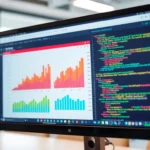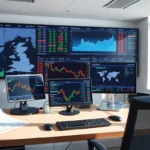Introduction to Trading View and Its Key Features
In the fast-paced world of financial markets, having access to real-time data, advanced charting tools, and a vibrant trading community can make all the difference in making informed investment decisions. trading view has emerged as a leading platform that integrates these elements seamlessly, empowering traders and investors worldwide. Its reputation as a “super-charting platform” and social network for market enthusiasts highlights its multifaceted approach to financial analysis and community engagement.
TradingView’s significance lies in its ability to combine sophisticated technical analysis tools with a user-friendly interface, making it accessible even to novice traders while offering advanced features for seasoned professionals. Whether you’re tracking cryptocurrencies, stocks, forex, commodities, or indices, TradingView provides comprehensive tools to analyze, discuss, and execute trades effectively.
Core Tools and Charting Capabilities
At its core, TradingView boasts a robust charting engine that supports multiple chart types such as candlestick, line, bar, and more. Its intuitive interface allows users to customize timeframes, color schemes, and layout configurations, enabling tailored visualizations for different trading strategies.
One of the standout features is the extensive library of technical indicators, including Moving Averages, MACD, RSI, Bollinger Bands, and numerous others. Users can also apply custom indicators developed through TradingView’s scripting language, Pine Script, which enhances analytical flexibility. The ability to Layer multiple indicators and compare different securities side by side enables traders to uncover deeper insights into market trends.
Integration with real-time data feeds ensures that charts reflect the latest market movements, and the platform supports multiple asset classes, from cryptocurrencies like Bitcoin (see Bitcoin chart) to traditional stocks and commodities. These capabilities make TradingView a versatile tool for both day traders and long-term investors.
Community and Social Trading Aspects
Beyond its analytical prowess, TradingView fosters an active community of traders and investors who share ideas, strategies, and market forecasts. Its social features include the ability to publish trading ideas, comment on others’ analyses, and follow top traders to observe their insights and trade setups.
This social dynamic not only enriches the learning experience but also allows users to validate their analysis through crowd-sourced perspectives. The platform’s idea-sharing feature is particularly valuable for newer traders seeking mentorship and for seasoned professionals looking to showcase their expertise. Additionally, community ideas can be filtered by popularity, asset class, and timeframe, making it easier to discover relevant insights.
The integration with social media platforms like Twitter (X) extends TradingView’s reach, enabling traders to discuss and disseminate ideas beyond the platform itself. This ecosystem creates a collaborative environment where knowledge is continually exchanged, ultimately fostering a more informed trading community.
Effective Strategies for Using Trading View
Customizing Charts for Different Markets
Every market demands tailored analytical approaches. TradingView allows users to customize charts according to the asset type and their trading style. For example, day traders might focus on short-term minute charts with specific indicator setups, while swing traders may prefer daily or weekly views with trend-following tools.
Utilize color schemes and layout configurations to quickly identify bullish and bearish signals. Save multiple chart templates for different markets or strategies, ensuring rapid switching during active trading sessions.
Setting Alerts and Notifications
One of TradingView’s powerful features is its customizable alert system. Traders can set alerts based on price movements, indicator thresholds, or specific chart patterns. For instance, an alert can notify you when Bitcoin crosses a significant resistance level or when the RSI indicates overbought conditions.
These alerts help in managing trades proactively, even when you’re away from your desk. Setting alerts on your mobile device through TradingView’s app ensures you stay connected with market developments in real-time.
Analyzing Trends with Technical Indicators
Technical indicators are the backbone of TradingView analysis. Mastering their application helps in recognizing market patterns and timing entries or exits. Combining moving averages with oscillators like RSI can improve predictive accuracy. For example, a trader might look for a bullish crossover of short-term moving averages combined with RSI divergence to confirm a trend reversal.
Backtesting strategies on historical data within TradingView allows traders to refine their setups and optimize parameters, reducing trial-and-error during live trading.
Integrating Trading View into Your Investment Workflow
Combining Trading View with Other Analysis Tools
While TradingView offers comprehensive analysis features, it’s often beneficial to integrate it with other tools for a holistic approach. Combining TradingView charts with fundamental analysis platforms or economic calendars can enrich your decision-making process.
Use TradingView’s ability to export charts or embed widgets within your trading journal or decision-making dashboards. This seamless data flow supports more informed and timely trades.
Developing a Trading Plan Based on Data
A structured trading plan rooted in data and technical analysis minimizes emotional trading. Use TradingView to identify entry and exit points, define position sizes, and establish stop-loss orders based on chart support and resistance levels.
Maintain records of your analysis and trade outcomes directly within the platform or through integrated journaling tools. Continuous evaluation of your trading plan’s performance helps in adapting strategies to changing market conditions.
Performance Metrics and Monitoring Results
Consistent monitoring is vital for sustainable trading success. TradingView provides performance tracking features, including profit/loss dashboards, trade statistics, and visual overlays of your strategy performance.
Regularly reviewing these metrics enables you to identify strengths and weaknesses, fostering a cycle of continuous improvement.
Advanced Tips for Experienced Traders
Creating and Sharing Trading Ideas
Advanced traders can leverage TradingView’s idea-sharing platform to build a reputation and contribute insights. Creating clear, well-annotated charts enhances the value of your analysis. Sharing successful trade setups can attract followers and foster a network of collaborators.
Using Scripts and Custom Indicators
Developing custom indicators using Pine Script allows traders to tailor analytical tools to specific strategies. Whether it’s designing a new oscillator or specialized pattern recognition tool, scripting enhances analytical depth and automation potential.
Automating Trading Strategies
Although TradingView itself does not execute trades, its compatibility with third-party brokers and trading bots enables automated trading based on predefined scripts and signals. This automation can improve reaction times and reduce emotional bias, especially in high-frequency trading scenarios.
Future Trends and Innovations in Trading View
Mobile Trading and App Enhancements
As mobile trading continues to dominate, TradingView is investing in app enhancements to improve usability, speed, and feature parity with desktop versions. Expect smoother interfaces, more customizable alerts, and better integration with broker APIs on mobile devices.
Real-Time Data Improvements
Access to faster, more accurate real-time data remains a priority. Future updates may include wider market coverage, more granular data feeds, and lower latency, all crucial for high-frequency traders and scalpers.
Community Engagement and Social Features
Enhanced social interactions, such as live webinars, collaborative trading rooms, and more interactive community features, are on the horizon. These developments aim to deepen community engagement and democratize market insights further.









